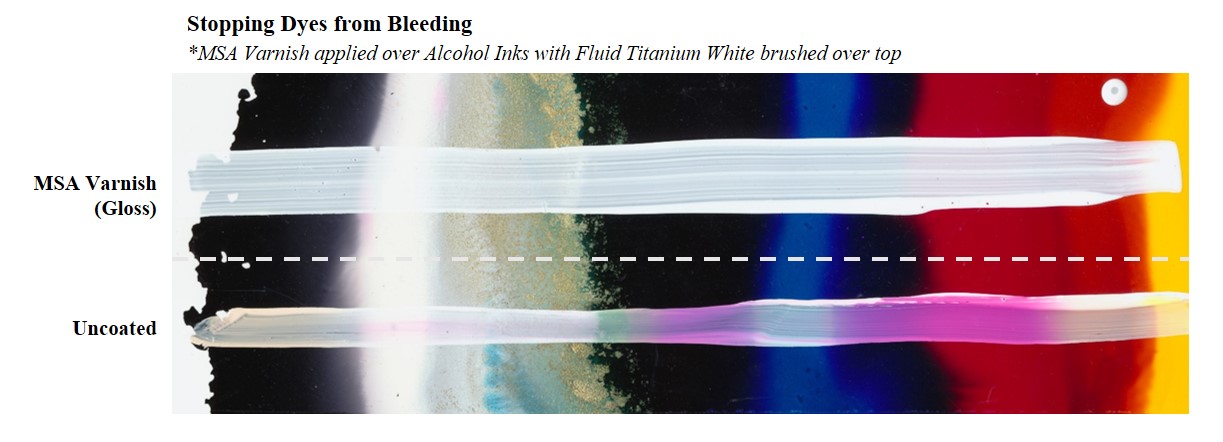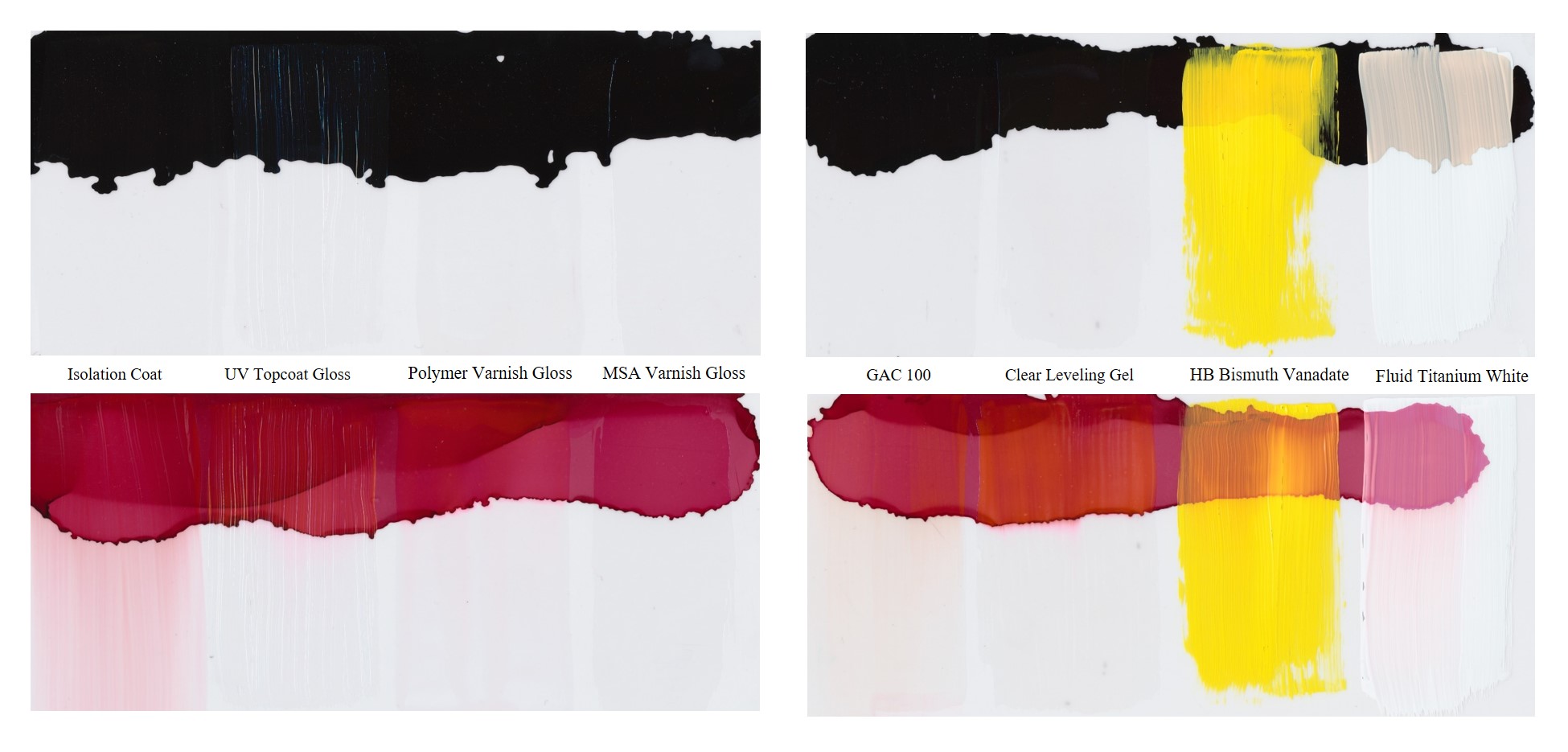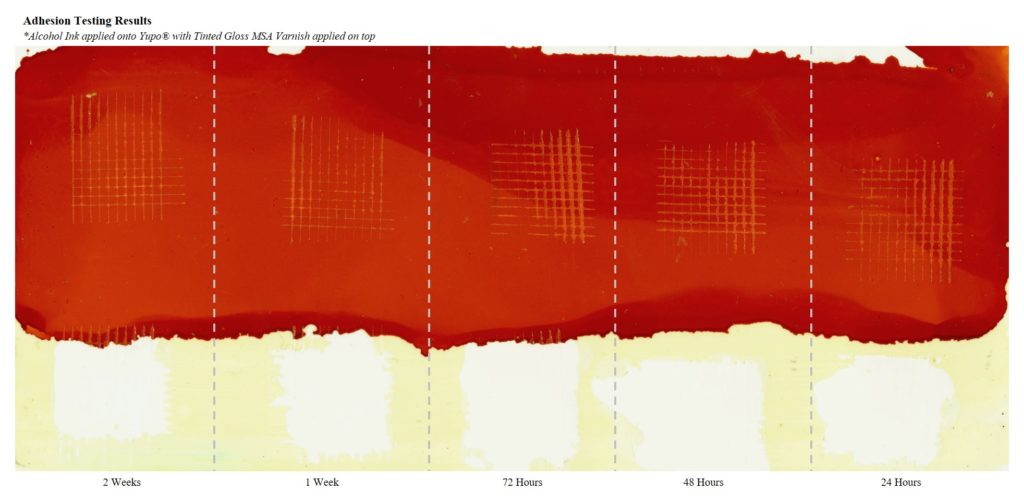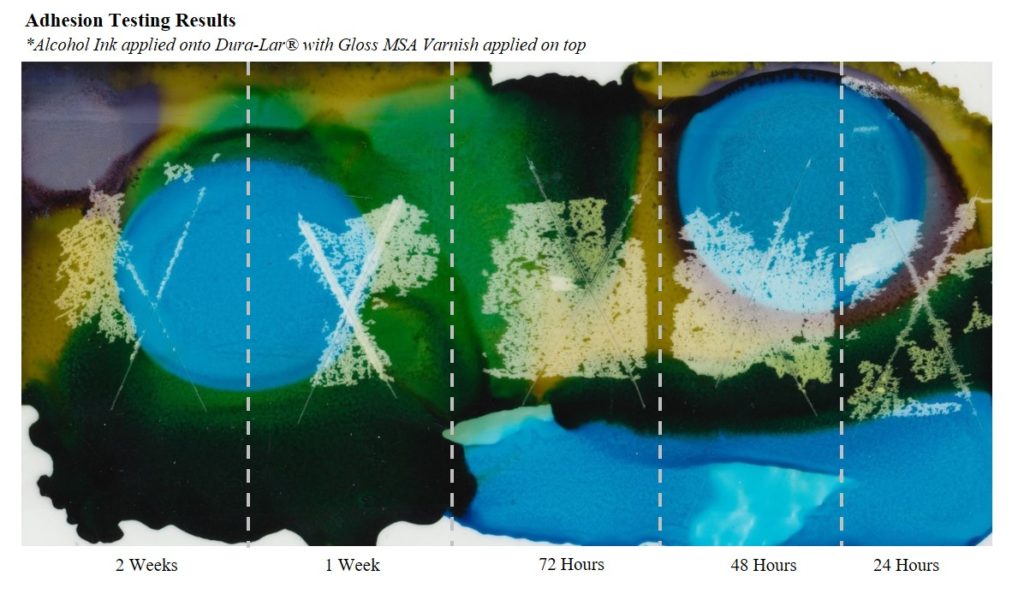
In response to recent questions we have received from artists about the compatibility of using our GOLDEN Acrylics and Varnishes with alcohol inks, we decided to test these materials together. Our results were varied, with varnish testing in particular having more inconsistent results than we expected due to the wide range of alcohol inks available and the properties of individual dyes. In the end, the best recommendation we can make is to test your materials and observe any recommendations an alcohol ink manufacturer may make about using their products. We would also encourage artists who are interested in low viscosity paint or paint at an ink-like consistency to try our High Flow acrylics. While they are not a direct match with alcohol inks in terms of working characteristics, they performed great in varnish testing and are compatible with all acrylic paints, gels, mediums and varnishes.
We start this article by giving some context, describing the differences between pigmented acrylics and dye-based alcohol inks. This article will also illustrate the sensitivity testing we performed on alcohol inks with our acrylic products and the results of our varnish testing. This is all aimed to help artists have an idea of what to expect when the two mediums are inter-layered or mixed with one another.
Pigments vs Dyes
In general what differentiates a dye from a pigment is solubility. Dyes are soluble, meaning they are made of small molecules that are dissolved into a liquid and are traditionally absorbed into a material. Pigments are made from larger particles that cannot be dissolved, so they must be suspended in a binding material such as an acrylic resin. The pigmented acrylic paint, for example, bonds to a surface rather than solely soaking into it as with a dye. Alcohol inks, while dye-based, are a little different than a traditional dye in that they are dissolved in alcohol along with a resin and as the alcohol evaporates, it creates a thin loosely bound film. This film, once dried, will remain re-soluble in its vehicle, alcohol. A pigmented system like acrylic paint will not remain re-soluble in water after it has dried. Pigments in general are simply more lightfast or resistant to fading in UV light.
Sensitivity Testing of Alcohol Inks
A common question is whether or not one of our varnishes could be used to provide UV protection. To answer this, we tested our line of varnish products over the alcohol inks in addition to a range of Acrylic Paints, Mediums and Gels. We conducted these tests on sheets of matte Dura-Lar®, which is a translucent, non-absorbent polyester film. We applied the alcohol inks at the top, letting them dry for a full 24 hours and the next day we brushed over top of them with our acrylics and varnishes to see if there was any interaction between the two. 
The picture on the left shows results from brushing GOLDEN Isolation Coat, UV Topcoat Gloss, Polymer Varnish Gloss and our Gloss MSA Varnish. The picture on the right shows Medium GAC 100, Clear Leveling Gel, Heavy Body Acrylic color Bismuth Vanadate and Fluid Acrylic color Titanium White brushed on top of a magenta alcohol ink. The results of our testing were interesting, the magenta alcohol ink showed clear signs of color lift when layered over with water-based acrylics. Only our solvent-based Gloss MSA Varnish showed no interaction with the ink. We could also see that the dye-based ink was clearly bleeding or migrating through the acrylic layers, which is most visible with the Fluid Titanium White and Heavy Body Bismuth Vanadate. It is also worth noting how differently each product interacted with the magenta alcohol ink. In some cases, there was discoloration and color lift while in others, just color lift. Since the results were so varied we decided to increase the number of colors we tested and broaden the number of alcohol ink brands we tested as well.
We also performed the same tests using black and crimson alcohol inks and in both cases, the results were much different than with the magenta. The black lightened some with the UV Topcoat, but overall showed minimal signs of sensitivity towards the acrylics beyond bleeding into the Fluid and Heavy Body acrylics. The crimson showed some color lift and bleed and like the magenta, there was some variability of how the ink interacted with the acrylics. The main take away here is that with such varied results it is of paramount importance an artist test first prior to using acrylics with the alcohol inks.
Archival Spray Varnish Test Results
 On a separate test piece using alcohol inks on matte Dura-Lar®, we tested our Archival Spray Varnish. After waiting 24 hours for our test sample to dry, we sprayed over top of the inks to see if there would be any interaction between them. In the image on the left, the Archival Spray Varnish, during application, reactivated the alcohol inks causing them to run. We wanted to reproduce this test to see if we got the same results again and interestingly the second time, using the same testing parameters with different colors, we saw sensitivity localized mainly to thinner areas of the magenta. The Archival Spray Varnish contains acetone, a fast drying solvent, which could be contributing to greater sensitivity. With such varied results, our testing led us to conclude that different alcohol ink dyes or brands express different degrees of vulnerability and if you wanted to use Archival Spray Varnish to finish, we would recommend testing first.
On a separate test piece using alcohol inks on matte Dura-Lar®, we tested our Archival Spray Varnish. After waiting 24 hours for our test sample to dry, we sprayed over top of the inks to see if there would be any interaction between them. In the image on the left, the Archival Spray Varnish, during application, reactivated the alcohol inks causing them to run. We wanted to reproduce this test to see if we got the same results again and interestingly the second time, using the same testing parameters with different colors, we saw sensitivity localized mainly to thinner areas of the magenta. The Archival Spray Varnish contains acetone, a fast drying solvent, which could be contributing to greater sensitivity. With such varied results, our testing led us to conclude that different alcohol ink dyes or brands express different degrees of vulnerability and if you wanted to use Archival Spray Varnish to finish, we would recommend testing first.
Xenon Testing of MSA Varnish
The Gloss MSA Varnish, unlike the Archival Spray Varnish did not disturb the alcohol inks, but how effective is the MSA Varnish in lightfast testing? It is important to state upfront that the MSA Varnish, by filtering UV light, may help slow down the rate at which dye-based alcohol inks may fade, but it will not transform the dyes themselves into more lightfast materials. We created several samples of the dye-based alcohol inks applied directly on top of Dura-Lar® as well as samples of the alcohol inks applied over GOLDEN Acrylic Gesso. We also tested our High Flow Acrylics in the same fashion to see how well they performed when compared to the alcohol inks. All samples were subjected to 410 hours of accelerated lightfast testing in a Xenon arc light chamber, which is equivalent to several months of outdoor exposure and 100 years of indoor gallery lighting conditions. For more information on how we test for lightfastness check out our Just Paint article:
Lightfastness Testing at Golden Artist Colors
When observing the results of our testing, it was immediately clear that there was variability between the two dye-based alcohol inks that were sampled in how well they performed in lightfast testing. While the MSA Varnish helped on some level to filter the UV light, the magenta faded greatly and became strongly discolored. The cyan performed much better, still exhibiting some color shift, but this was visibly improved by two brushed on layers of Gloss MSA Varnish. Our High Flow Acrylics showed no visible change when put through the same testing. Both colors have an ASTM lightfast rating of 1, which is excellent. High Flow being ink-like in its consistency could be an alternative for some artists who like working thinly and are concerned with the lightfastness of their colors.
The results were interesting on our test pieces where the alcohol inks were applied over GOLDEN Acrylic Gesso on Dura-Lar®. The magenta alcohol ink faded away even with two layers of MSA Varnish. There was evidence, in the magenta, of discoloration and bleed into the gesso on the unexposed portion as well. This surprised us, because it developed over several weeks while we waited for the xenon testing to complete. When this same sample was flipped over, it seemed as though the MSA Varnish in some areas encouraged the dyes to migrate through the gesso more, being slightly darker in areas of the varnish portion. The take away here is that there is apparent variability between alcohol inks and individual dyes and there also seems to be a correlation between the degree to which an alcohol ink color bleeds or expresses sensitivity and how well it may perform in lightfast testing.
Adhesion Testing
While we were waiting for Xenon testing results, we also did a range of adhesion testing to make sure that the Gloss MSA Varnish would stick to the alcohol inks. It is of paramount importance an artist test first prior to using acrylics with the alcohol inks to assure there is proper adhesion of each to a chosen substrate. We tested alcohol inks applied over Yupo®, a non-absorbent, synthetic paper and applied a tinted MSA Varnish over top so we could have a visual confirmation of any adhesion issues. Acrylics, in general, have poor adhesion when applied directly to Yupo®, which is not recommended. Over the span of two weeks, we checked to see how well the alcohol ink adhered to the Yupo and how well the MSA Varnish adhered to the ink and if adhesion improved over time.
What we observed was that the MSA Varnish adhered well to the alcohol inks even improving slightly over time and the alcohol ink we tested also showed good adhesion to the Yupo®. The tinted MSA Varnish applied directly over the Yupo® continued to fail even after two weeks.
We also did another adhesion test at the same time of the alcohol inks over the Dura-Lar® with MSA Varnish applied over top. The alcohol inks had poor adhesion to the Dura-Lar® and as the inks lifted off, they took the varnish with them. This creates an obviously complicated situation when using alcohol inks with GOLDEN Acrylics and Varnishes. On Yupo® adhesion of acrylics is poor and on Dura-Lar® adhesion of the alcohol inks is poor. For more information on how to do adhesion testing refer to our Just Paint Article:
Will It Stick? Simple Adhesion Testing In Your Studio
Various Other Acrylic and Alcohol Ink Observations
Our last bit of testing focused on a range of topics outside of varnish testing, but for artists who are interested in mixed media where the two mediums may come into contact with another.
Direct Intermixing of Acrylics and Alcohol Inks
 What happens when you directly mixed acrylics with alcohol inks? To find out, we did mixtures with both our Fluid Titanium White and GAC 100. It was of note that alcohol inks performed differently depending on their color, but in all cases we were unable to create homogeneous mixtures of the two. The dyes seemed to flocculate or clump together. We also dropped alcohol inks into a wet layer of Fluid Titanium White to see how they would react. Within seconds we observed a fracturing or breaking up of the alcohol inks, highlighting apparent incompatibilities between the two and based on these results, we would caution against mixing alcohol inks directly with acrylics. When we flipped the dried acrylic skin over there was also clear signs of dyes migrating through the dried acrylic. Interesting again was the variability between colors.
What happens when you directly mixed acrylics with alcohol inks? To find out, we did mixtures with both our Fluid Titanium White and GAC 100. It was of note that alcohol inks performed differently depending on their color, but in all cases we were unable to create homogeneous mixtures of the two. The dyes seemed to flocculate or clump together. We also dropped alcohol inks into a wet layer of Fluid Titanium White to see how they would react. Within seconds we observed a fracturing or breaking up of the alcohol inks, highlighting apparent incompatibilities between the two and based on these results, we would caution against mixing alcohol inks directly with acrylics. When we flipped the dried acrylic skin over there was also clear signs of dyes migrating through the dried acrylic. Interesting again was the variability between colors.
Stopping Dyes from Bleeding
 Since most of the tests showed dyes from the alcohol inks bleeding through subsequent layers of dried acrylics, we wanted to do more testing to see if we could somehow block this from happening. We applied a layer of MSA Varnish over the alcohol inks and after this was dry, we brushed out Fluid Titanium White over top for a visual confirmation of bleed. Ultimately, we observed that the MSA Varnish successfully stopped the dyes from bleeding into the white. It is important to note that we generally do not recommend painting with acrylics over top of our varnishes as they are removable. If the varnish were ever to be removed, anything painted over top could come off with it. If there were ever a need to stop dyes from bleeding by using the MSA Varnish in an area, we recommend applying an Isolation Coat to fully encapsulate the MSA making it a permanent part of the piece and then an artist could varnish again over top.
Since most of the tests showed dyes from the alcohol inks bleeding through subsequent layers of dried acrylics, we wanted to do more testing to see if we could somehow block this from happening. We applied a layer of MSA Varnish over the alcohol inks and after this was dry, we brushed out Fluid Titanium White over top for a visual confirmation of bleed. Ultimately, we observed that the MSA Varnish successfully stopped the dyes from bleeding into the white. It is important to note that we generally do not recommend painting with acrylics over top of our varnishes as they are removable. If the varnish were ever to be removed, anything painted over top could come off with it. If there were ever a need to stop dyes from bleeding by using the MSA Varnish in an area, we recommend applying an Isolation Coat to fully encapsulate the MSA making it a permanent part of the piece and then an artist could varnish again over top.
Applying Alcohol Inks Over Acrylic Grounds
 We also wanted to see if acrylics could make a suitable ground for alcohol inks or for mixed media artists who may at some point inter-layer the two. Several test pieces were coated with GOLDEN Acrylic Gesso, as well as Gloss and Matte Mediums, then alcohol inks were dropped over top. The absorbency of the Gesso and porosity of the acrylics dramatically slowed down the movement of the alcohol inks causing denser puddling and uneven coverage. We also observed subtle differences between the brands we tested and how they interacted with the acrylics when applied over top. To test further, we poured out a larger amount of alcohol ink and spread it out over the acrylic Gesso to have a larger surface area. Initially the alcohol inks did well, but over time in one of the brands, the film of alcohol ink began to crack. In light of this we recommend testing and observing any recommendations an alcohol ink manufacturer may make about how to apply the alcohol inks.
We also wanted to see if acrylics could make a suitable ground for alcohol inks or for mixed media artists who may at some point inter-layer the two. Several test pieces were coated with GOLDEN Acrylic Gesso, as well as Gloss and Matte Mediums, then alcohol inks were dropped over top. The absorbency of the Gesso and porosity of the acrylics dramatically slowed down the movement of the alcohol inks causing denser puddling and uneven coverage. We also observed subtle differences between the brands we tested and how they interacted with the acrylics when applied over top. To test further, we poured out a larger amount of alcohol ink and spread it out over the acrylic Gesso to have a larger surface area. Initially the alcohol inks did well, but over time in one of the brands, the film of alcohol ink began to crack. In light of this we recommend testing and observing any recommendations an alcohol ink manufacturer may make about how to apply the alcohol inks.
It is our hope that this testing is helpful in providing some information and context around our recommendations for testing when using GOLDEN Acrylics and Varnishes with alcohol inks. If you have any questions or comments about this article or any other paint related topic, please feel free to contact our Materials Application Department at [email protected] or by calling 800-959-6543.
*Wicks, Z. W., Frank N. Jones, S. Peter Pappas; consultant, Douglas A. Wicks. (2007). Organic coatings: science and technology (3rd ed.). Hoboken, New Jersey: Wiley
About Scott Fischer
View all posts by Scott Fischer -->Subscribe
Subscribe to the newsletter today!
No related Post






Thank you so much for this article! Your testing is much appreciated.
Hi Scott,
I appreciated your article. I have been using alcohol inks on Ampersand claybord. The inks seem to absorb into the clay coating. I have been using Golden Archival Varnish – Mineral Spirit Acrylic Aerosol w/UVLS-gloss
( #7731-X ). I have not noticed any migration of the inks. Does this make sense? I would appreciate your opinion.
Thanks so much,
Hello Jaci,
Thanks for reaching out to us! What we saw in our testing is highly absorbent surfaces like Clayboard tend to quickly pull in a lot of the alcohol leaving a very sensitive or under bound layer of ink on top. We even observed some cracking with one of the brands we tested over an absorbent surface like our Acrylic Gesso. We have not tested the Clayboard with alochol inks, so this is something you might want to test yourself or look out for when you are using these materials together. In general, we would recommend following any specific recommendations made by an alcohol ink manufacturer for what surfaces works best with their products. As far as using the Archival Varnish Gloss to varnish alcohol inks, we had mixed results in our testing. With some brands it seemed to reactivate the inks, with others it seemed to only affect certain colors or more thinner applications of the ink. We would again recommend doing some testing first to be sure this would work for you. We had best results using the Archival Varnish over the alcohol inks by ensuring we were spraying 12 inches away from the surface, but again our results were varied depending on the inks we tested and what surfaces they were applied to. The migration of inks or the bleeding through of inks we mainly observed when we applied acrylics over the inks themselves. We did not observe inks migrating through layers of varnish, we actually saw that it help to stop inks from migrating.
We hope this answers your questions, if you have more questions please contact us at [email protected] or call us at 800-959-6543 we are happy to help!
Best,
Scott
I really love Golden Products because I find you have a wonderful customer service department and really listen to your customers.
Thanks for this article. What brand of alcohol inks did you test with? Not all inks are created equal. Depending on the brand or colour used, you will get different results.
Hello Jane,
Yes, that is the big take away here. We recommend testing for your application, when possible, since there is such variability between brands. We also observed a lot of variability between colors within a single brand. As you say, not all inks or dyes (colorants) are created equal. Out of respect for these companies, unfortunately, we cannot disclose which brands we tested for the article.